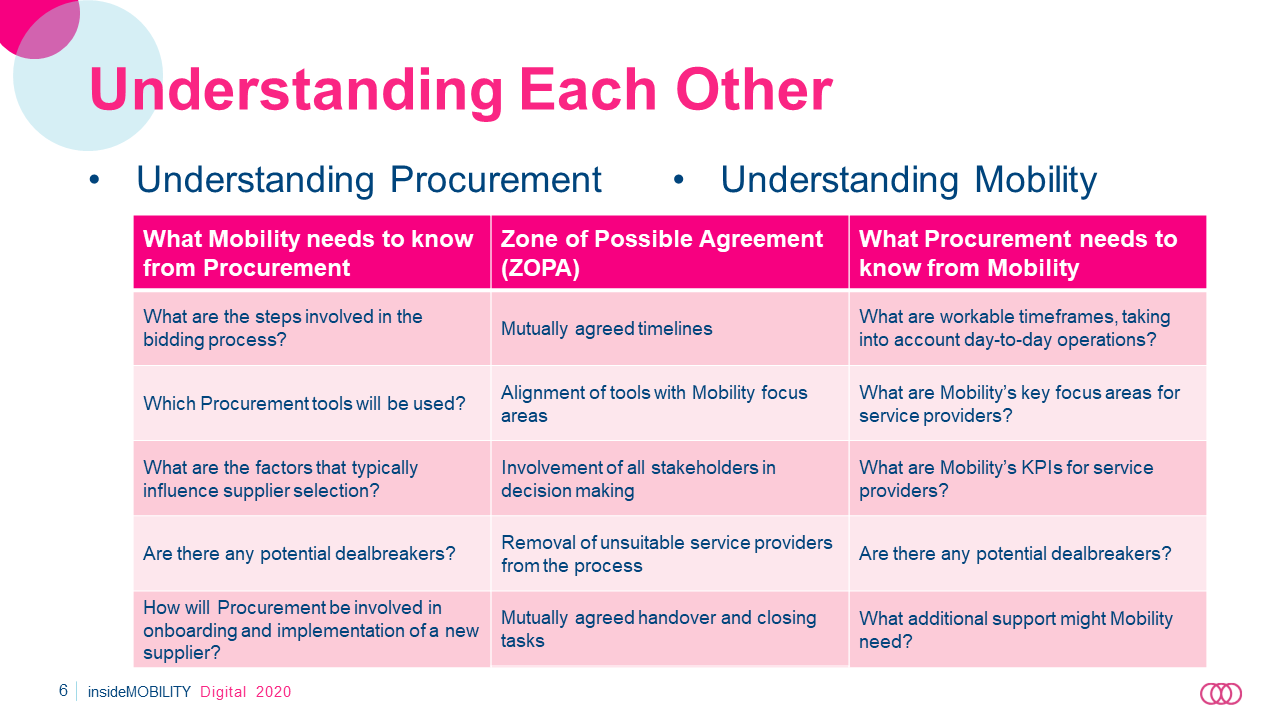4 Steps to Bridging the RFP Gap Between Global Talent Mobility and Procurement

Best Practices to Ensure Collaboration and a Successful Outcome
How can Global Talent Mobility and Procurement find common ground and sustain an equal footing in the Request for Proposal (RFP) development process for the selection of a Relocation Management Company (RMC) or other Mobility service provider? It’s not always easy because the respective roles and operating styles of these two functions are significantly different.
Global Talent Mobility programs are designed to move people and teams around the world in support of corporate goals and objectives. Their measures of success are primarily qualitative. For example, the satisfaction of the employee and their family is extremely important as it relates to achieving an ‘exceptional experience’; as is the employee’s ability to quickly and productively integrate into their new assignment.
In contrast, Procurement’s institutional role is to ensure that quality goods and services are purchased at the lowest cost and best terms. Thus, Procurement’s measures of success are primarily quantitative: reducing the cost per relocation, in the case of Global Talent Mobility.
However, it’s important that these two corporate functions work together, committing to a process that balances the priorities of both in a way that best serves the organization and its most important asset – its people.
In this article, we’ll describe how to make that happen from the Mobility team perspective – and you’ll learn how you should engage with Procurement during the RFP process.
General versus Categorized Procurement Professionals – What’s the Difference?
Depending on the organization (and generally its culture, size and/or complexity), Mobility may find itself working with two types of Procurement professionals, both equally focused on analytical and data functions:
- Procurement Generalist Managers have a deep expertise in the Procurement and RFP process, but they’re generalists when it comes to corporate functions. They move from project to project across the organization.
- Procurement Category Managers have the same expertise but also have a deeper familiarity with specific corporate functions, services and/or product lines. Often, they’ve worked on Procurement matters in those functional areas before.
The advantage of working with a Procurement Category Manager (who often specializes in the HR function) is that their expertise in Global Talent Mobility can shorten the education and familiarization process described in Step One (below).
The Source of the Challenge
In a recent insideMOBILITY® Digital webinar on this subject we asked Global Mobility leaders about the source of their challenges in working with Procurement within their organizations The results are summarized below:
.

Two of the three top answers reference the lack of understanding about respective functions, processes and methods. The numbers suggest that Mobility doesn’t understand or perhaps appreciate the processes and methods Procurement must adhere to. Conversely, Procurement often may not comprehend or recognize Mobility’s purpose, processes and measures of success.
Further, as noted in the second most popular answer, Mobility is often frustrated by Procurement’s focus on bottom-line costs. That shouldn’t be surprising – Mobility should always remember that Procurement is charged with obtaining the best value for each major corporate expenditure. They need to demonstrate a quantifiable value-add for new expenditure levels.
That’s why it’s Mobility’s job to bring additional data and reasoning to the table. After all, Global Mobility programs should also be quantitatively driven, capturing and monitoring data that extends well beyond costs, and encompasses factors like service quality and employee satisfaction to name just two.
Step one – understand each other
The second table (below) from the webinar, lays out the broad parameters about the information exchange that must take place before the development of the Mobility services RFP. Once that information is established and clearly understood, Mobility and Procurement can create “Zones of Possible Agreement,” the second column, the mutually agreed upon parameters that will guide the RFP and selection process moving forward.

Equally important in this mutual understanding of roles is educating Procurement about the strategy of the mobility function. Developing goals and objectives for the Mobility Program and sharing the ‘Return on Mobility’ (ROM) and value of its function to Procurement is critical to getting their buy in. As partners during an RFP process, this approach lets them know that a logical progression of strategic steps, ROM metrics and analysis and stakeholder engagement considerations will elevate the Mobility program and RFP process to set it up for success.
Step two – prepare to engage
Now that Mobility has reached an understanding with Procurement about the strategy of the function, processes, tools, roles and other elements of the RFP process, it’s time to gather information to feed into the process. It’s important to be pro-active in this regard to maintain an equal standing with Procurement in the process. To compile this information, Mobility may need to engage other stakeholders throughout the company, including:
- Finance – to obtain scoring and cost data related to Mobility spending
- Information Technology – to review current management platforms and the IT-related “must-haves” the supplier will need to conform with
- Talent Development and Key Business Units– to determine if policies should be streamlined or revised and to review upcoming corporate expansion or consolidation plans that would impact Mobility activity
Step three – compile your information
Mobility should not only anticipate the kind of cost information Procurement will want to see, but also the additional information it wants add to the mix, like:
- Mobility volume, placement rate, satisfaction scores, assignment completions and the number and cost of escalations
- The scope of Mobility services currently in place and any plans to expand or retract those services
- Service level expectations and actual scores as well as the methods for collecting and managing that data
- The systematic and strategic approach of creating an Exceptional Employee Experience as a way to attract and retain employees by focusing on “Moments that Matter”
- The potential financial impact of a failed assignment so Procurement can better appreciate the consequences of cutting corners and taking chances with sub-par service providers
- Dealbreakers in the selection process and the characteristics of an RMC or Mobility service provider that would make them unacceptable or unqualified
Step four – devote the necessary time to the process
With all of this in place, it’s important for Mobility to stay engaged and preserve its opportunity to weigh in on the language of the RFP and throughout the selection process itself. This isn’t the time to turn things over to Procurement. That may be tempting, though, because for Mobility the RFP process is an added daily responsibility, whereas for Procurement, this work is their primary function.
Mobility must be engaged as much as possible all the way to completion – the selection of the RMC or Mobility service partner. For a successful outcome Mobility must be guided by this principle:
Create an information-rich, collaborative tone and process in which Mobility and Procurement are pulling together in the same direction with full transparency.
We can help you weigh in on your internal RFP process using our RFP toolkit which includes, discovery questions to assess your needs, a scorecard, cost savings tool and a pricing grid. Each of these items can be customized to suit your unique business goals. Contact us for more information.